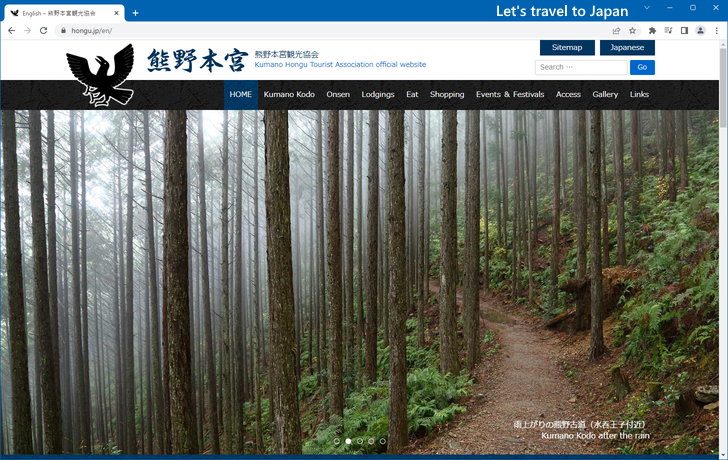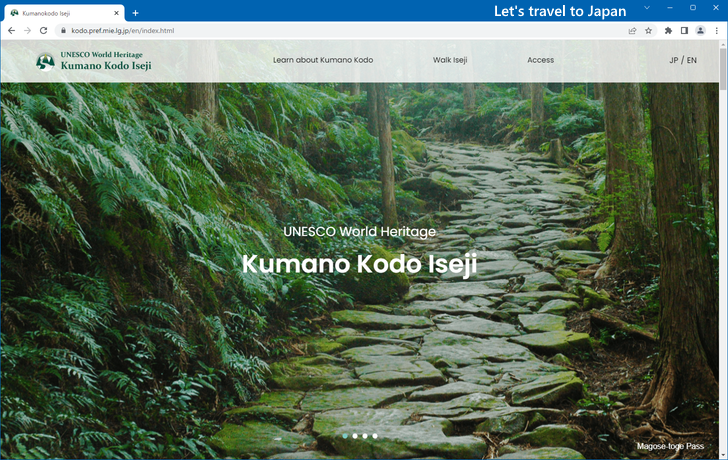Highlights and access methods of Kumano Kodo (Mie and Wakayama Prefecture)
In this article, we will explain the attractions of Kumano Kodo in Mie and Wakayama Prefecture and how to access it for those who are traveling to Japan from overseas.

(Last modified: )
(Prefecture : Mie Wakayama , Category : Nature and Scenic Spots)
Table of contents
About Kumano Kodo
Kumano Kodo refers to a series of ancient pilgrimage routes on the Kii Peninsula in Japan, which has been designated as a UNESCO World Heritage site. These sacred trails, dating back over a thousand years, wind through dense forests, mountains, and rural villages, connecting the three revered Kumano Sanzan shrines: Kumano Hongu Taisha, Kumano Hayatama Taisha, and Kumano Nachi Taisha. The Kumano Kodo offers a unique blend of natural beauty, spiritual history, and cultural heritage, attracting both pilgrims and tourists alike for an unforgettable journey.
Highlights of Kumano Kodo
The Kumano Kodo, a network of ancient pilgrimage routes in the Kii Mountain Range in Japan, is a captivating destination for tourists seeking a spiritual and cultural experience. Spanning across Wakayama, Nara, and Mie Prefectures, these sacred trails have been used for over a thousand years by pilgrims seeking to visit the revered Kumano Sanzan shrines: Kumano Hongu Taisha, Kumano Hayatama Taisha, and Kumano Nachi Taisha.
Hiking the Kumano Kodo allows visitors to immerse themselves in the region's stunning natural beauty, passing through dense forests, remote villages, and historic sites. The trails offer various levels of difficulty, catering to both experienced hikers and casual walkers. Along the way, travelers can encounter ancient stone paths, moss-covered shrines, and traditional teahouses, providing a glimpse into Japan's spiritual past.
In 2004, the Kumano Kodo was designated as a UNESCO World Heritage site, further emphasizing its cultural and historical significance.
As for the best season to visit, the Kumano Kodo can be enjoyed throughout the year, with each season offering unique scenery. Spring (March to May) is particularly beautiful due to the cherry blossoms and vibrant greenery, while autumn (September to November) showcases a stunning display of colorful foliage. Summer (June to August) is lush and green, but can be hot and humid, while winter (December to February) is colder and may have snow in some areas.
In conclusion, the Kumano Kodo is a fascinating destination for tourists seeking a spiritual and cultural experience amidst Japan's breathtaking natural beauty. The ancient trails and historic sites provide an unforgettable journey through the country's rich history and traditions.
Address and access method of Kumano Kodo
The Kumano Kodo pilgrimage routes span across the Kii Peninsula in Japan, so there isn't a specific address for the entire trail network. However, key destinations along the routes include the Kumano Sanzan shrines:
Kumano Hongu Taisha: 1110 Hongucho Hongu, Tanabe, Wakayama 647-1731, Japan.
Kumano Hayatama Taisha: 1 Hayatamacho Kamihon, Shingu, Wakayama 647-0062, Japan.
Kumano Nachi Taisha: 1 Nachisan, Nachikatsuura, Higashimuro District, Wakayama 649-5301, Japan.
Nakahechi route
If you plan to walk the Nakahechi route of the Kumano Kodo pilgrimage, your journey will typically start from Tanabe City in Wakayama Prefecture.
To reach Tanabe from major cities such as Tokyo, Osaka, or Kyoto, you can take the Shinkansen (bullet train) to Shin-Osaka Station. From Shin-Osaka, take the JR Kuroshio limited express train to Kii-Tanabe Station. The journey takes about 2.5 hours.
The Nakahechi route officially begins at Takijiri-oji, which is about a 40-minute bus ride from Kii-Tanabe Station. Buses run by the Kumano Kotsu Bus Company connect Kii-Tanabe Station and Takijiri-oji. The bus schedule is not very frequent, so it's a good idea to check it ahead of time.
The Nakahechi route is the most popular among the Kumano Kodo trails, and it takes you through beautiful mountains to Kumano Hongu Taisha, one of the three grand shrines of Kumano. Depending on your pace, this journey could take two to three days.
Many pilgrims choose to stay overnight in the small towns of Chikatsuyu or Tsugizakura, which have traditional Japanese inns (ryokan) and guesthouses. From Kumano Hongu Taisha, you can extend your pilgrimage to the other two grand shrines, Kumano Hayatama Taisha and Kumano Nachi Taisha, or take a bus back to Kii-Tanabe Station.
Remember to prepare for the journey with appropriate clothing, footwear, and supplies, and ensure you have a detailed map or navigation device. Also, it's important to check the weather forecast and trail conditions before you set off.
Hosshinmon Oji to Kumano Hongu Taisha
To access Hosshinmon-oji, which is one of the significant sites on the Kumano Kodo pilgrimage route and the entrance to the sacred area around Kumano Hongu Taisha, you would typically start from Tanabe City in Wakayama Prefecture.
The most common way to reach Tanabe is by train. From major cities such as Tokyo, Osaka, or Kyoto, you can take the Shinkansen (bullet train) to Shin-Osaka Station. From Shin-Osaka, take the JR Kuroshio limited express train to Kii-Tanabe Station. The journey takes about 2.5 hours.
From Kii-Tanabe Station, take a local bus operated by the Kumano Kotsu Bus Company to Hosshinmon-oji. The bus ride takes approximately 90 minutes. Be sure to check the bus schedule ahead of time, as services are not very frequent.
Once you reach Hosshinmon-oji, you can start your journey on the Kumano Kodo pilgrimage route towards Kumano Hongu Taisha. Please ensure you have appropriate clothing and supplies for the hike, as it's a roughly 7km journey through mountainous terrain.
Iseji route
If you're planning to walk the Kumano Kodo Iseji route to Kumano Hongu Taisha, your journey will start from Ise, Mie Prefecture, home to the famous Ise Grand Shrine.
To reach Ise from major cities such as Tokyo, Osaka, or Kyoto, you can take the Shinkansen (bullet train) to Nagoya Station. From Nagoya, take the Kintetsu Railway's limited express train to Iseshi or Ujiyamada Station in Ise City. The journey from Nagoya to Ise takes approximately 1.5 to 2 hours.
The Iseji route of the Kumano Kodo begins at Ise Grand Shrine. From there, the trail spans over 170 kilometers southward along the Mie Prefecture coast to Kumano, Wakayama Prefecture.
The Iseji route is made up of multiple trails, some of which traverse mountainous terrain, while others follow the coastline. Depending on your pace and how much you choose to walk each day, the journey could take a week or more.
As you prepare for your journey, please keep in mind that some sections of the trail are quite remote, and services are sparse. Ensure you have appropriate clothing, footwear, and supplies, and consider using a navigation app or GPS device to assist with navigation.
Arriving at Kumano Hongu Taisha from the Iseji route requires you to pass through multiple towns such as Owase, Kumano City, and Tanabe City in Wakayama Prefecture. Once you reach Hongu Town, Kumano Hongu Taisha is a short walk away.
Please note that this is a significant journey, and it is crucial to plan your route and accommodations thoroughly. It's also a good idea to check the weather forecast and trail conditions before you set off.
Attractions near Kumano Kodo
There are several other attractions near the Kumano Kodo pilgrimage routes that are worth visiting:
Mount Koya
A sacred mountain and UNESCO World Heritage site, home to the headquarters of the Shingon sect of Japanese Buddhism and the atmospheric Okunoin Cemetery.
Yoshino
A renowned cherry blossom viewing spot in the Nara Prefecture, boasting thousands of cherry trees that cover the slopes of Mount Yoshino.
Nachi Falls
The tallest waterfall in Japan, located near Kumano Nachi Taisha, featuring a 133-meter drop and breathtaking natural beauty.
Ise Grand Shrine
One of Japan's most sacred Shinto shrines, located in Ise City, Mie Prefecture, and dedicated to the sun goddess Amaterasu.
Shirahama
A coastal town in Wakayama Prefecture famous for its white sand beach, hot springs, and Adventure World, a popular amusement park.
These attractions, along with the Kumano Kodo pilgrimage routes, showcase the Kii Peninsula's diverse natural, cultural, and historical experiences, making it an ideal destination for travelers seeking to explore Japan's rich heritage.
Other information about Kumano Kodo
Official site (English version) about Kumano Kodo :

https://www.kodo.pref.mie.lg.jp/en/index.html

Thank you for reading to the end.
( Written by Tatsuo Ikura )